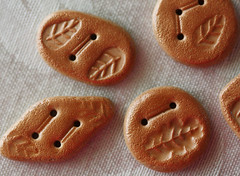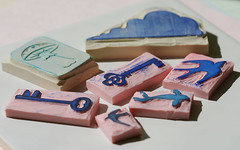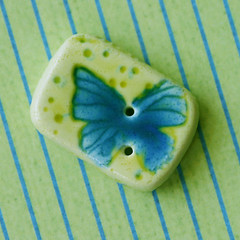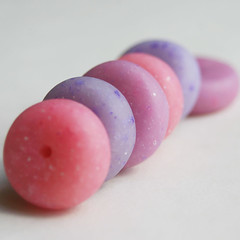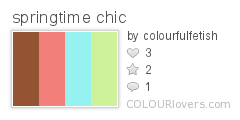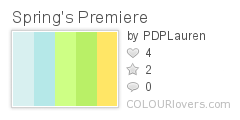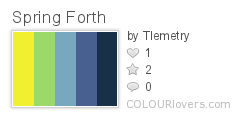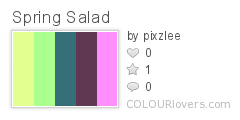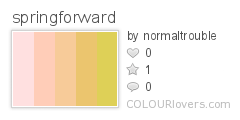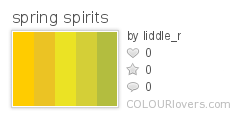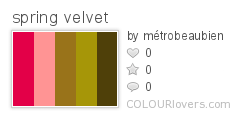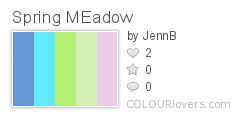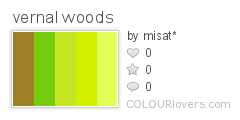We're probably going to have some bad weather in this area early tomorrow morning, so just to be on the safe side, I'm posting this a bit early. I hope your week's off to a great start! :o)
~ ~ ~ ~ ~
After pouring your heart and soul into a piece of work, wouldn't you like to "leave your mark" on it? Paintings are usually signed-- literature is printed with the author's name prominently displayed-- why not include your own signature, initials, or other personal mark on your polymer clay creations?
Obviously, this can be a bit tricky if you make small objects like beads-- and personally I never sign that type of thing-- but it can certainly be done. If you make larger-scale items, it's easy to find a spot to "sign" in one way or another. It's just a matter of deciding how to do it. . .
Ten on Tuesday: Ten Ways to Sign Your Work--1. Sign with a pen.Perhaps the most straightforward way to sign your work is to write your name directly on the object (usually on the bottom of the piece or another hidden, inconspicuous spot). What is less straightforward is what ink works best. Some pens (such as Sharpies) can bleed into the clay over time.
This page at Glass Attic contains information on a variety of different pens and how they work with polymer clay.
Before you use a new pen to sign your name on a creation that took twenty hours of your life to make, I'd suggest running a series of tests on small scraps of clay. Be aware that it can take months to determine for certain how an ink will behave on the clay.
2. Sign with paint. If you have a steadier hand with a paintbrush than I do ;o) , you may want to sign your work with paint. Just as with pens, there's the possibility of the paint bleeding into the clay-- particularly with red paint. Experiment on scrap clay to be on the safe side. It can take a while for the bleeding to become obvious, so date your tests and come back to them every so often.
One extra precaution you can take is to seal your cured piece prior to signing. Seal again (with Future, Varathane, etc.) to protect your signature.
There's more about paints and clay on
this page of Glass Attic.
3. Carve it. One simple way of signing your work is to carve your name or mark directly into the clay. If you do this prior to curing, you can use almost anything from a needle tool to a ball-ended stylus to do the "carving". The disadvantage to doing this pre-curing is that it's easy to distort the clay or mar your work. Carving your name after curing, on the other hand, will require that you use some sharp instrument. You may be able to use a craft knife, but if you have
linoleum cutters (such as the set from Speedball), they're better for carving cured clay. (Be careful when you use any sharp tool. Practice using the linoleum cutters on cured scrap clay before trying them on anything special. Go slowly-- move the piece you're carving instead of the cutter-- and keep the cutter pointed away from you and your hands.)
Once you've carved your piece (and cured it, if you carved it raw), you can make your signature more visible by either antiquing it with acrylic paint or backfilling with a contrasting color of clay. (If you use clay, remember to cure the piece a second time!)
4. Transfer it. I don't know that I've ever seen or heard of anyone doing this before, but I don't see any reason why it couldn't work. There are numerous methods of transferring images. Some require special papers and/or ink jet printers. For others, you need nothing more than a toner copy (think Xerox machine copy), clay (preferably in a light color), and water. Using your preferred image transfer method, you could sign your work with your name in any font you like, with a copy of your own actual signature, or with any "mark" or symbol you like. Just keep in mind whether or not your chosen method of image transfer will reverse the image. If it will, remember to mirror the image before printing it.
5. Make a signature cane. I haven't heard much about this, lately, but some artists make a cane with their initials, logo, or other signature mark, then incorporate thin slices of it into their work. For larger pieces, you could work a slice of the cane into the design or embed it into the bottom of the object. Making a cane of this type may be a bit daunting for someone new to millefiori, but it's something to consider.
This video starring Marie Segal includes information on making a signature cane.
6. Have a custom stamp made.If you have the cash to spare, you can have your own designs made into a sheet of rubber stamps. You can easily fit a number of small "signature stamps" into one of these, with room to spare.
Sarajane Helm has written about her experience having custom stamps made by Ready-Stamps. Use your custom-made signature stamp to leave an impression of your name or mark-- usually in an inconspicuous spot, such as the bottom. To make the signature more visible, you can antique it, backfill it, or highlight it with mica powder, acrylic paint, or rub-on wax.
7. Use a ready-made stamp.Ok, maybe it's not ideal, but if you're short on funds, but already have an alphabet of rubber stamps, you can use those to sign your work. With larger stamps, you may have room only to leave your initials, but some stamps are small enough that you can fit in your full name. Don't forget the alphabet stamps you can find beyond the confines of the rubber stamp aisle of the craft store! The tiny stamp sets used in address stamps are great for polymer clay. You can also use metal stamps meant for marking serial numbers, etc., in metal surfaces.
If you're planning to sell what you make using rubber stamps, it's a good idea to check out the company's
"Angel company policy". This will tell you whether or not it's legal to use the stamped image in artwork you intend to sell. There are variations in policy from company to company. Personally, I feel this should be much less of an issue if the stamp is used on the back or bottom of a piece purely to "sign" the work-- but use your own discretion.
8. Make a "2-step stamp".You can make your own custom stamps out of polymer clay-- not only of your signature or "mark", but of anything you like! To make a "2-step stamp", start by carving your design. You can use raw clay or cured clay. Just be sure it's thick enough that you can carve your design without going through the bottom. Try to maintain a consistent depth throughout the design. If you need a guide to follow, you could either transfer an image of the design onto the clay or draw it by hand before carving. (If you carved raw clay, cure it before proceeding.)
Step two is to take a cast from your freshly carved mold. (Wait until it has cooled, if you just cured it.) Use a release agent and press raw clay into the cured mold (the thing you carved). This will create a "raised" version of your design, which you can cure and use as a stamp. If you notice that you didn't manage to keep the depth consistent in your carving, parts of your new stamp may be taller than others. You may be able to even things out a little by sanding it against a flat surface.
If you're very good with the carving tools, you may be able to condense this process by simply carving the raised design directly out of the first block of clay. This can be a bit messy, though, if your design is very detailed.
9. Make a "credit card stamp". This is an idea I found in
Donna Kato's latest book. She describes Jacqueline Lee's signature stamp this way: "To sign her artwork, Jacqueline Lee makes a mold from her name on a credit card and then presses raw clay into the mold. She then presses the clay to the piece." I haven't tried it yet, myself, but if your work is of a size to accept that type of signature, it seems like a pretty nifty idea!
10. Make an "extruded snake stamp".Visit Polymer Clay Central to see
Kathy Canuel's tutorial for a custom-made polymer clay stamp using an extruded snake of clay to make a quick and easy stamp. You'll need an extruder, some liquid clay, and regular polymer clay. The tutorial demonstrates making a word stamp ("Hope"), but you can use the same technique for any word, name or symbol you choose. In Kathy's examples at the end of the tutorial, you can see her personal "mark" for signing her work.
As you can see, there are methods to suit every style, budget, and application. I hope you've found one that you'd like to try. :o)
~ ~ ~ ~ ~
P.S. You know what they say about great minds thinking alike? ;o) Well, the day after writing this (I sometimes do these in advance, when I'm in a bloggy mood, so that I don't have to scramble on Tuesday morning), I saw that I wasn't the only one inspired by Kathy Canuel's tutorial. Angela (Crafty Goat) has also written about ways to make your own stamp-- including a variation on Kathy's technique. Some of our ideas were the same, but there are other techniques on her list that aren't on mine, so if you haven't already seen that blog post, you might want to head
over there and have a look. :o)
Actually, there could be several blogs with posts similar to this, and I probably wouldn't know about it, at the rate I read blogs these days. . . (g) So if it ever looks like I'm copying your blog, please know that it isn't intentional. At the very least, I try to mention and link to the blogs I copy. ;o)
~ ~ ~ ~ ~
P.P.S. My temporary loss of internet access was only part of my recent computer-related woes. We also lost all our saved e-mail. I know that I had received at least one e-mail in response to my earlier post,
"Any suggestions?". Unfortunately, I hadn't even had a chance to read it, so if that person sees this and is able to resend the e-mail, I'd appreciate it. I'm sorry for the inconvenience. At least everything is up and running again, now. :o)









